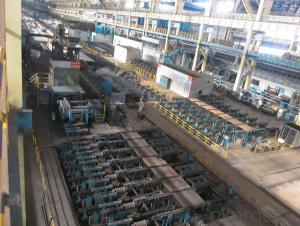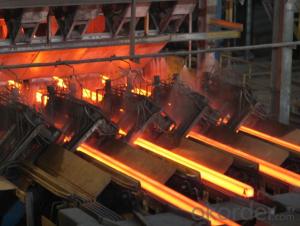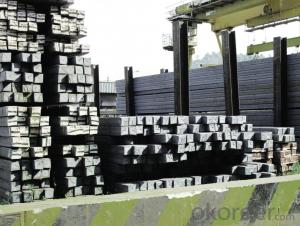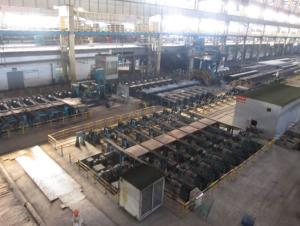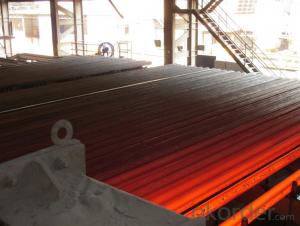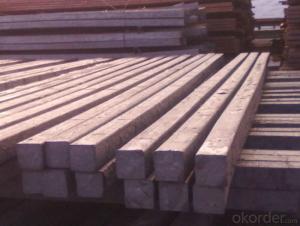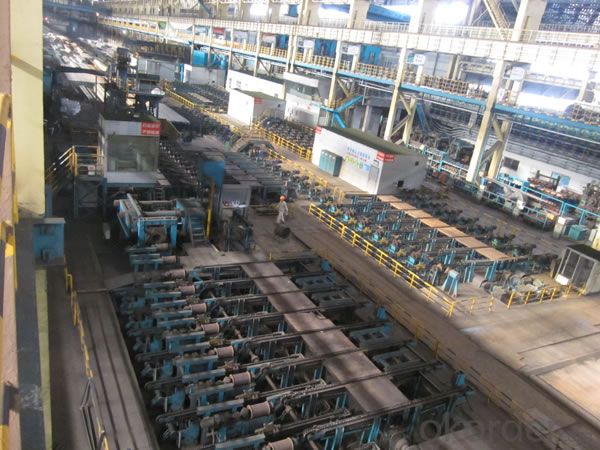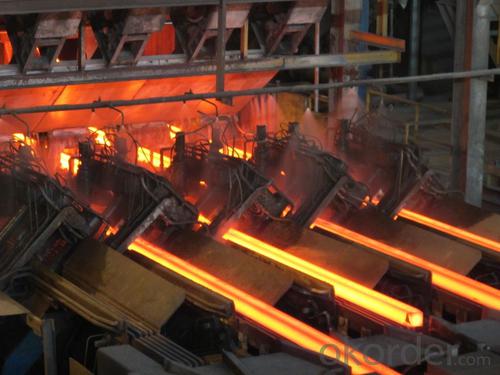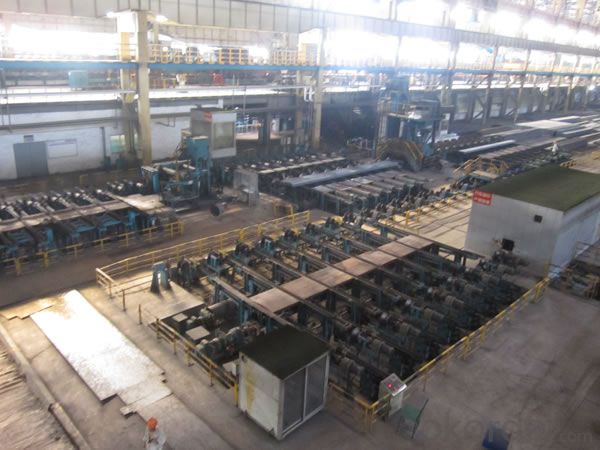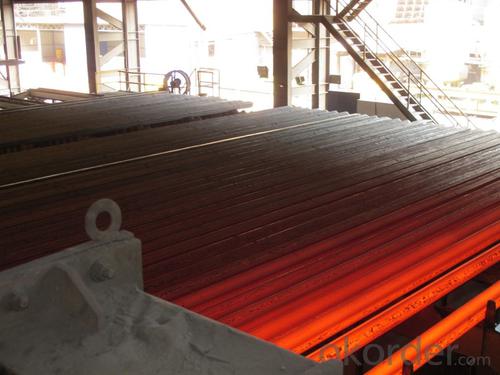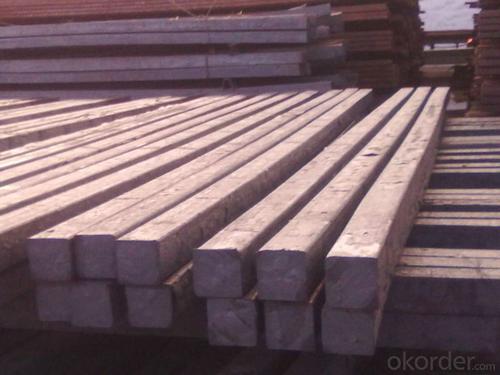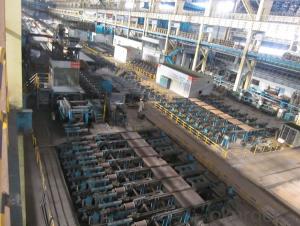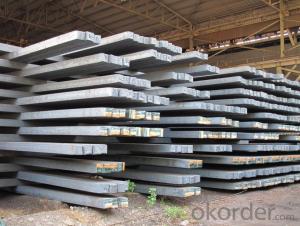Prime square alloy steel billet 95mm Q235
- Loading Port:
- Shanghai
- Payment Terms:
- TT OR LC
- Min Order Qty:
- 100 m.t.
- Supply Capability:
- 10000 m.t./month
OKorder Service Pledge
OKorder Financial Service
You Might Also Like
Structure of Prime square alloy steel billet 95mm Q235
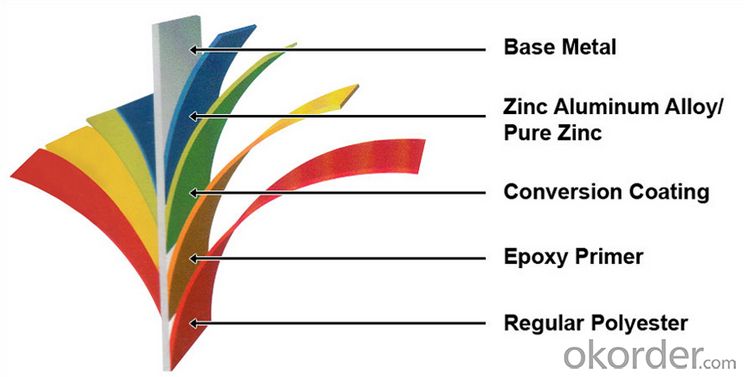
Description of Prime square alloy steel billet 95mm Q235
1. Prepainted steel coil is coated with organic layer, which provides higher anti-corrosion property and a longer lifespan than that of galvanized or galvalume steel sheets.
2. The base metals for prepainted steel coil consist of cold rolled, HDGI Steel, electro-galvanized and hot-dip alu-zinc coated steel. The finish coats of prepainted steel coil can be classified into groups as follows: polyester, silicon modified polyesters, polyvinylidene fluoride, high-durability polyester, etc.
3. The production process has evolved from one-coating-and-one-baking to double-coating-and-double-baking, and even three-coating-and-three-baking.
4. The color of the prepainted steel coil has a very wide selection, like orange, cream-colored, dark sky blue, sea blue, bright red, brick red, ivory white, porcelain blue, etc.
5. The prepainted steel coils can also be classified into groups by their surface textures, namely regular prepainted sheets, embossed sheets and printed sheets.

Main Feature of Prime square alloy steel billet 95mm Q235
Uncoated CR steel sheet
With the features of in line with the international highest standards in demension and shape, excellent surface finish and properties, the products are mainly used in home appliance and automobile industries.
Galvanized steel sheet(include HDG and EG)
With the features of good corrosion resistance, the products are mainly used in automobile, home appliance, electronics, building and machinery manufacture industries, etc.
Precoated steel sheet
With the features of enviromental protection and good processablility, long lasting surface durability, rich in colors, the products are maily used in building, home appliance and furniture industries, etc.
Applications of Prime square alloy steel billet 95mm Q235
Polyester Coating Thickness:Top and Back coating thickness depend by Buyer Requirement.
Polyester Coating Type:2/2,1/2m,1/2.
Polyester Type: Polyester, silicone modified polyester, high durability polyester (HDP), polyvinylidene fluoride (PVDF)
Unit Roll Weight:5-20tons
Place of Origin Shanghai , China (Mainland)
Surface Treatment :Color Coated

Specifications of Prime square alloy steel billet 95mm Q235
Product | Billet |
Material Grade | SGCC / SGCH / DX51D+AZ, etc |
Thickness | 0.6-3.0mm |
Width | 500-1500mm |
Tolerance | Thickness: +/-0.02mm , Width:+/-2mm |
Zinc-coating | Z30-150g/m2 |
Technique | Raw material: Hot rolled steel coil --> Cold rolled_>hot dipped galvalume |
Surface | Dried, Chromated, Unoiled |
Spangle | Regular spangle , small spangle, zero spangle |
ID | 508MM 610MM |
Coil weight | 1-25MT |
Export package | Cardboard inner sleeves, Waterproof paper, galvanized steel covered and steel strip packed |
FAQ of Prime square alloy steel billet 95mm Q235
We have organized several common questions for our clients,may help you sincerely:
1. How Can I Visit There?
Our company is located in Tianjin City, China, near Beijing. You can fly to Tianjin Airport Directly. All our clients, from home or aboard, are warmly welcome to visit us!
2. How Can I Get Some Sample?
We are honored to offer you sample.
3. Why choose CNBM?
we always fix steel produce in container well to make it safe arrive at destination port
we always provide best and professional forward service for our buyer
we always apply 14days free detention for our buyers container in destination
we provide one set After-sales service for our buyer
we provide China inland steel market price report
we help our buyer become number one in local market .
- Q: Can steel billets be used for making musical instruments?
- Musical instruments can indeed be crafted from steel billets. Although conventional instruments are typically fashioned from wood or brass, steel offers a distinctive and contemporary alternative. The strength and durability of steel render it well-suited for certain instruments, including steel drums and steel guitars. Moreover, steel's adaptability permits the formation of intricate designs and shapes, resulting in a broad spectrum of sounds. Nevertheless, it is crucial to acknowledge that the specific attributes and properties of the steel utilized, such as its composition and thickness, will heavily influence the instrument's sound and quality. Therefore, meticulous consideration and experimentation may prove necessary in order to achieve the desired musical tones and effects when employing steel billets for instrument production.
- Q: How are steel billets used in the manufacturing of oil and gas industry components?
- Steel billets are used in the manufacturing of oil and gas industry components as they serve as the starting material for various products such as pipes, valves, fittings, and flanges. These billets are heated and shaped through processes like forging, rolling, or extrusion to create the desired form and strength required for the specific component. The resulting steel components are then used in the construction and operation of oil and gas infrastructure, ensuring reliability, durability, and performance in challenging operating conditions.
- Q: What are the different methods of steel billet surface grinding?
- There are several methods of steel billet surface grinding, including abrasive grinding, belt grinding, and centerless grinding.
- Q: How are steel billets different from steel bars?
- Steel billets and steel bars are both primary forms of steel, but they differ in terms of their shapes and sizes. Steel billets are typically larger in size and have a square or rectangular cross-section, while steel bars are smaller and have a round, square, or hexagonal cross-section. Billets are raw materials used for further processing, such as forging or rolling, to produce steel bars or other steel products. Conversely, steel bars are the end products that are commonly used in construction, manufacturing, or fabrication applications.
- Q: How do steel billets contribute to the overall seismic resistance of a structure?
- The overall seismic resistance of a structure is greatly improved by the presence of steel billets. When incorporated into concrete structures, steel billets act as reinforcement, boosting the structure's strength and longevity. This reinforcement enables the structure to better endure the forces and vibrations unleashed by earthquakes. The impressive tensile strength of steel billets enables them to efficiently absorb and distribute seismic energy, significantly decreasing the likelihood of structural failure during an earthquake. Moreover, steel billets have the capacity to be transformed into specialized structural elements, such as braces or shear walls, which are strategically positioned within the structure to counteract the lateral forces resulting from earthquakes. By utilizing steel billets, these structural elements are able to effectively absorb and disperse the seismic energy, successfully safeguarding the overall structure from substantial harm. Furthermore, steel billets are instrumental in the construction of seismic dampers, which are devices created to soak up and dissipate the energy generated by seismic events. When steel billet-based dampers are installed, the structure is able to significantly diminish the transfer of seismic energy to the building, thereby minimizing the potential for damage. Additionally, steel billets possess outstanding ductility, which is the capacity to deform without breaking. During an earthquake, structures experience considerable movement and vibrations. The ductile nature of steel allows it to flex and bend under these forces, proficiently absorbing seismic energy and preventing sudden, catastrophic failure of the structure. In conclusion, steel billets enhance the overall seismic resistance of a structure by providing additional strength and durability, facilitating the creation of specialized structural elements, enabling the construction of seismic dampers, and offering exceptional ductility. Their application elevates the structure's ability to withstand seismic forces, reducing the risk of damage and ensuring the safety of its occupants.
- Q: How do steel billets contribute to the manufacturing of sports equipment?
- Steel billets contribute to the manufacturing of sports equipment by providing a strong and durable material for various components. These billets are often used to create the frames, shafts, and other structural parts of sports equipment such as golf clubs, tennis rackets, and bicycles. The high strength and resilience of steel make it ideal for handling the rigorous demands of sports activities, ensuring that the equipment can withstand impact, vibrations, and repetitive use. Additionally, steel billets can be easily shaped and molded into different forms, allowing manufacturers to create customized designs that enhance performance and optimize weight distribution.
- Q: What are the different types of steel used in manufacturing steel billets?
- There are several different types of steel used in the manufacturing of steel billets. Some of the most common types include carbon steel, stainless steel, alloy steel, and tool steel. 1. Carbon Steel: This is the most commonly used type of steel for manufacturing steel billets. It contains a small amount of carbon, typically around 0.05% to 0.25%, which gives it its strength and durability. Carbon steel is versatile and can be used in a wide range of applications. 2. Stainless Steel: Stainless steel is known for its corrosion resistance and high strength. It contains chromium, which forms a protective oxide layer on the surface, preventing rust and corrosion. Stainless steel is often used in applications where resistance to moisture and chemicals is required, such as in the construction of bridges and buildings. 3. Alloy Steel: Alloy steel is made by adding various alloying elements to carbon steel, such as manganese, nickel, chromium, and molybdenum. These elements enhance the steel's properties, such as its strength, hardness, and resistance to wear and tear. Alloy steel is commonly used in the automotive and aerospace industries. 4. Tool Steel: Tool steel is specifically designed to have high hardness, abrasion resistance, and the ability to withstand high temperatures. It is often used in the production of cutting tools, molds, and dies. Tool steel is typically made with a combination of alloying elements, such as tungsten, vanadium, and cobalt. These are just a few examples of the different types of steel used in the manufacturing of steel billets. The selection of the specific type of steel depends on the desired properties and the intended application of the steel billets.
- Q: What are the main challenges in manufacturing steel billets?
- There are several main challenges in manufacturing steel billets. One of the primary challenges is the need for high-quality raw materials. Steel billets are typically produced from scrap metal or iron ore, and ensuring that the raw materials meet the required specifications is crucial for producing high-quality billets. Contaminants in the raw materials can lead to defects in the final product, affecting its strength and performance. Another challenge is maintaining consistent and precise control over the manufacturing process. Steel billets need to be heated to a specific temperature and then cooled rapidly to achieve the desired metallurgical properties. This requires precise control of the heating and cooling rates, as well as the overall process parameters, such as time and pressure. Any deviations in these parameters can result in inconsistencies in the billets' properties, affecting their quality and suitability for various applications. Energy consumption is also a significant challenge in steel billet manufacturing. The process of heating and cooling the billets requires a significant amount of energy, contributing to high production costs and environmental impact. Finding ways to optimize energy usage and improve energy efficiency is a constant challenge for steel manufacturers. Furthermore, maintaining the equipment and machinery used in the production process is crucial. The high temperatures and harsh conditions in steel manufacturing can lead to wear and tear on the equipment, resulting in potential breakdowns and production delays. Regular maintenance and timely repairs are necessary to ensure smooth operations and minimize downtime. Safety is another vital challenge in steel billet manufacturing. The process involves handling heavy materials, high temperatures, and potentially hazardous chemicals. Implementing robust safety protocols, providing proper training to workers, and ensuring compliance with safety regulations are essential to create a safe working environment and prevent accidents or injuries. Lastly, market demand and competition pose challenges for steel billet manufacturers. The industry is highly competitive, and staying ahead requires continuous innovation, cost optimization, and the ability to adapt to changing market trends and demands. Meeting customer expectations, delivering on time, and maintaining high-quality standards are critical factors for success in the steel billet manufacturing industry.
- Q: How are steel billets used in the production of molds?
- Steel billets are an important component in the production of molds as they serve as the raw material for creating the mold itself. The process begins by selecting a suitable steel billet, which is typically a solid rectangular or square piece of steel. Once the steel billet is chosen, it undergoes a series of manufacturing processes to transform it into a mold. Firstly, the billet is heated to a high temperature, known as the forging temperature, which makes it malleable and easier to work with. This heating process is crucial as it allows the steel to be shaped and molded into the desired form. After heating, the steel billet is subjected to a variety of shaping techniques such as rolling, pressing, or hammering. These methods help to shape the steel into the desired mold design, which could be a simple or complex shape depending on the application. Once the desired shape is achieved, the steel billet is cooled down and undergoes further processes such as machining, grinding, and polishing to refine the mold's surface finish and dimensional accuracy. This ensures that the mold is precise and capable of producing high-quality products. Overall, steel billets are used in the production of molds as the base material that is shaped and refined to create a customized mold design. These molds are then used in various industries such as automotive, aerospace, and manufacturing to produce a wide range of products.
- Q: Does anyone know how much it costs to refine a ton of steel? What are the expenses involved?
- Electricity, water, wages, raw materials, raw materials loss, charges, oxygen, according to their own circumstances, as well as freight and other expenses,
Send your message to us
Prime square alloy steel billet 95mm Q235
- Loading Port:
- Shanghai
- Payment Terms:
- TT OR LC
- Min Order Qty:
- 100 m.t.
- Supply Capability:
- 10000 m.t./month
OKorder Service Pledge
OKorder Financial Service
Similar products
Hot products
Hot Searches
Related keywords
